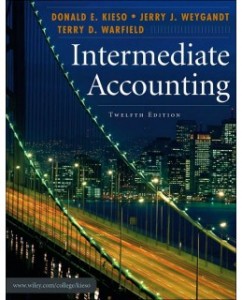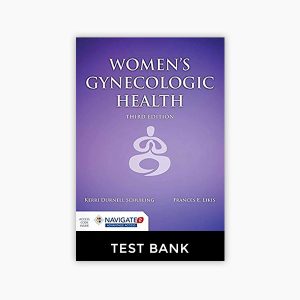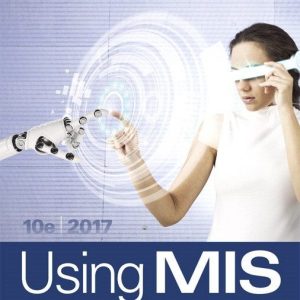This is completed downloadable of Test Bank for Intermediate Accounting, 12th Edition: Donald E. Kieso

Product Details:
- ISBN-10 : 0471749559
- ISBN-13 : 978-0471749554
- Author: Donald E. Kieso
The Gateway to the Profession99% of surveyed practicing accountants feel that Kieso, Weygandt, and Warfield’s Intermediate Accounting helped prepare them for success in professional practice.100% would recommend the text to someone currently studying for an accounting degree.80% said they referred to their copy when they first entered professional practice.Professionals who learned accounting from Intermediate Accounting find themselves well prepared to enter the workplace. So well prepared in fact, that many keep their copy of the text to refer to again and again. Why is this text so essential for professional success?* Currency–This 12th edition of Intermediate Accounting reflects the state-of-the-art in accounting today. The text is kept current with the Intermediate Accounting Newsletter, a periodical for users of the text that spotlights the very latest developments and their implications.* Real-world examples and illust
Table of Content:
- Chapter 1: The Canadian Financial Reporting Environment
- Financial Statements and Financial Reporting
- Standard Setting
- Generally Accepted Accounting Principles
- Challenges and Opportunities for the Accounting Profession
- Review and Practice
- Summary of Learning Objectives
- Practice Problem
- Key Terms
- Assignment Material
- Brief Exercises
- Cases
- Research and Analysis
- Chapter 2: Conceptual Framework Underlying Financial Reporting
- Conceptual Framework
- Qualitative Characteristics of Useful Information
- Elements of Financial Statements
- Foundational Principles
- Financial Reporting Issues
- IFRS/ASPE Comparison
- Review and Practice
- Summary of Learning Objectives
- Practice Problem
- Key Terms
- Assignment Material
- Brief Exercises
- Exercises
- Problems
- Cases
- Research and Analysis
- Chapter 3: Measurement
- Measuring Financial Statement Elements
- Measuring Fair Value Using IFRS 13
- Present Value Concepts
- IFRS/ASPE Comparison
- Review and Practice
- Summary of Learning Objectives
- Practice Problem
- Key Terms
- Assignment Material
- Brief Exercises
- Exercises
- Problems
- Cases
- Research and Analysis
- Chapter 4: Reporting Financial Performance
- Performance
- Quality of Earnings/Information
- Measurement of Income
- Discontinued Operations
- The Statement of Income and the Statement of Comprehensive Income
- The Statement of Retained Earnings and the Statement of Changes in Equity
- Disclosure and Analysis
- IFRS/ASPE Comparison
- Appendix 4A Application of the Cash and Accrual Bases of Accounting
- Review and Practice
- Summary of Learning Objectives
- Practice Problem
- Key Terms
- Assignment Material
- Brief Exercises
- Exercises
- Problems
- Case
- Integrated Cases
- Research and Analysis
- Chapter 5: Financial Position and Cash Flows
- Usefulness of the Statements of Financial Position and Cash Flows from a Business Perspective
- Usefulness and Limitations of the Statement of Financial Position
- Classification in the Statement of Financial Position
- Preparation of the Classified Statement of Financial Position (Balance Sheet)
- Other Required Disclosures
- Techniques of Disclosure
- Purpose, Content, and Format of a Statement of Cash Flows
- Preparation of the Statement of Cash Flows
- Usefulness of the Statement of Cash Flows
- IFRS/ASPE Comparison
- Appendix 5A Ratio Analysis: A Reference
- Review and Practice
- Summary of Learning Objectives
- Practice Problem
- Key Terms
- Assignment Material
- Brief Exercises
- Exercises
- Problems
- Cases
- Integrated Cases
- Research and Analysis
- Cumulative Coverage and Task-Based Simulation: Chapters 3 to 5 and Appendix C
- Chapter 6: Revenue Recognition
- Understanding the Nature of Sales Transactions from a Business Perspective
- The Asset-Liability Approach to Revenue Recognition: An Overview of the Five-Step Process
- Identifying the Contract with Customers—Step 1
- Identifying Separate Performance Obligations—Step 2
- Determining the Transaction Price—Step 3
- Allocating the Transaction Price to Separate Performance Obligations—Step 4
- Recognizing Revenue When (or As) Each Performance Obligation Is Satisfied—Step 5
- Earnings Approach to Revenue Recognition
- Other Revenue Recognition Issues
- Presentation and Disclosure
- IFRS/ASPE Comparison
- Appendix 6A Long-Term Contracts
- Percentage-of-Completion Method
- Zero-Profit Method
- Completed-Contract Method
- Losses on Long-Term Contracts
- Review and Practice
- Summary of Learning Objectives
- Practice Problem
- Key Terms
- Assignment Material
- Brief Exercises
- Exercises
- Problems
- Cases
- Integrated Cases
- Research and Analysis
- Chapter 7: Cash and Receivables
- Understanding Cash and Accounts Receivable
- Cash
- Receivables
- Recognition and Measurement of Accounts Receivable
- Impairment of Accounts Receivable
- Notes and Loans Receivable
- Derecognition of Receivables
- Presentation, Disclosure, and Analysis of Receivables
- IFRS/ASPE Comparison
- Appendix 7A Methods for Controlling Cash
- Review and Practice
- Summary of Learning Objectives
- Practice Problem
- Key Terms
- Assignment Material
- Brief Exercises
- Exercises
- Problems
- Cases
- Integrated Cases
- Research and Analysis
- Chapter 8: Inventory
- Understanding Inventory
- Recognition of Physical Goods Included in Inventory
- Inventory Errors
- Measurement of Inventory—Costs Included
- Measurement and Inventory Accounting Systems
- Measurement and Cost Formulas
- Measurement and the Lower of Cost and Net Realizable Value (LC&NRV) Principle
- Exceptions to Lower of Cost and Net Realizable Value
- Measuring Inventory Using Estimates
- Presentation, Disclosure, and Analysis
- IFRS/ASPE Comparison
- Appendix 8A The Retail Inventory Method of Estimating Inventory Cost
- Appendix 8B Accounting Guidance for Specific Inventory
- Review and Practice
- Summary of Learning Objectives
- Practice Problem 8.1
- Practice Problem 8.2
- Key Terms
- Assignment Material
- Brief Exercises
- Exercises
- Problems
- Cases
- Integrated Cases
- Research and Analysis
- Chapter 9: Investments
- Understanding Investments
- Measurement—Cost/Amortized Cost Model
- Measurement—Fair Value Through Net Income (FV-NI) Model
- Measurement—Fair Value Through Other Comprehensive Income (FV-OCI) Model
- Measurement—Impairment Models
- Strategic Investments—Investments in Associates
- Strategic Investments—Investments in Subsidiaries
- Presentation, Disclosure, and Analysis
- IFRS/ASPE Comparison
- Review and Practice
- Summary of Learning Objectives
- Practice Problem
- Key Terms
- Assignment Material
- Brief Exercises
- Exercises
- Problems
- Cases
- Integrated Cases
- Research and Analysis
- Cumulative Coverage and Task-Based Simulation: Chapters 6 to 9
- Chapter 10: Property, Plant, and Equipment: Accounting Model Basics
- Definition and Recognition of Property, Plant, and Equipment
- Cost Elements
- Measurement of Cost for Nonmonetary Exchange
- Measurement of Costs Associated with Specific Assets
- Measurement after Acquisition
- Costs Incurred after Acquisition
- IFRS/ASPE Comparison
- Appendix 10A Capitalization of Borrowing Costs
- Appendix 10B Revaluation: The Proportionate Method
- Review and Practice
- Summary of Learning Objectives
- Practice Problem
- Key Terms
- Assignment Material
- Brief Exercises
- Exercises
- Problems
- Case
- Integrated Cases
- Research and Analysis
- Chapter 11: Depreciation, Impairment, and Disposition
- The Importance of Depreciation, Impairment, and Disposition from a Business Perspective
- Depreciation
- Depreciation—Methods of Allocation and Calculation
- Depletion of Mineral Resources
- Other Depreciation Issues
- Impairment
- Held for Sale and Derecognition
- Presentation, Disclosure, and Analysis
- IFRS/ASPE Comparison
- Appendix 11A Depreciation and Income Tax
- Review and Practice
- Summary of Learning Objectives
- Practice Problem
- Key Terms
- Assignment Material
- Brief Exercises
- Exercises
- Problems
- Integrated Cases
- Research and Analysis
- Chapter 12: Intangible Assets and Goodwill
- The Business Importance and Characteristics of Goodwill and Intangible Assets
- Recognition and Measurement of Intangible Assets at Acquisition
- Recognition and Measurement of Internally Developed Intangible Assets
- Recognition and Measurement of Intangible Assets after Acquisition
- Specific Intangibles
- Impairment and Derecognition
- Goodwill—Recognition and Measurement
- Goodwill—Impairment
- Presentation, Disclosure, and Analysis
- IFRS/ASPE Comparison
- Appendix 12A Valuing Goodwill
- Review and Practice
- Summary of Learning Objectives
- Practice Problem
- Key Terms
- Assignment Material
- Brief Exercises
- Exercises
- Problems
- Integrated Cases
- Research and Analysis
- Task-Based Simulation and Cumulative Coverage: Chapters 10 to 12
- Chapter 0
- Analyze Business Transactions
- Journalize the Transactions
- Post to the Ledger Accounts
- Prepare a Trial Balance
- Journalize and Post Adjusting Entries: Deferrals/Accruals
- Prepare an Adjusted Trial Balance
- Prepare Financial Statements
- Journalize and Post Closing Entries
- Prepare a Post-Closing Trial Balance
- Appendix A: Time Value of Money Tables
- Appendix B: Specimen Financial Statements
- Appendix C: The Accounting Information System
- Accounting System Overview
- The Accounting Cycle and the Recording Process
- Adjusting Entries
- Financial Statements and Ownership Structure
- The Closing Process
- Using a Work Sheet
- Review and Practice
- Summary of Learning Objectives
- Key Terms
- Assignment Material
- Brief Exercises
- Exercises
- Problems
- Appendix D: CPA Competency Map Coverage
- Appendix E: A Summary of the Case Primer
- GLOSSARY
- COMPANY INDEX
- SUBJECT INDEX
- EULA





